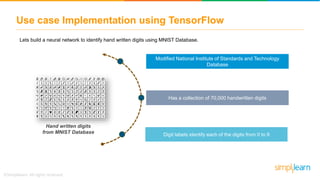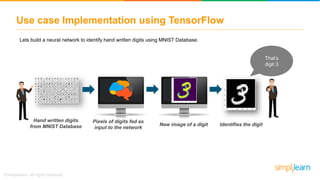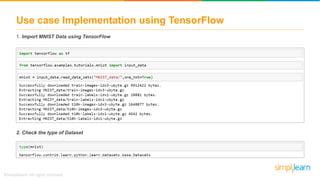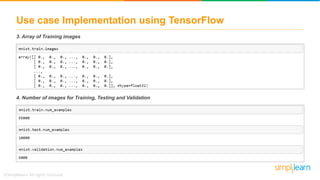Deep Learning Tutorial | Deep Learning TensorFlow | Deep Learning With Neural Networks | Simplilearn
- 2. Geolocation with Neural Network How does a neural network recognize the location of an image? Artificial Neural Network New image of a placeImages of millions of places Identifies the place
- 3. Geolocation with Neural Network Pixels of millions of images Feed to Neural Network Recognizes landmarks, landscapes, architectural styles, road signs, etc New image of a place Identifies the place How does a neural network recognize the location of an image?
- 4. What’s in it for you? Types of Neural Networks Applications of Deep Learning Working of Neural Network Introduction to TensorFlow Use case implementation using TensorFlow What is Deep Learning? What is a Neural Network? Implementing Logic Gates using Perceptron What is a Perceptron? Why do we need Deep Learning?
- 5. What is Deep Learning?
- 6. What is Deep Learning? Deep Learning is a subset of Machine Learning that has networks which are capable of learning from data that is unstructured or unlabeled and works similar to the functioning of a human brain. Artificial Intelligence Machine Learning Deep Learning Ability of a machine to imitate intelligent human behavior Application of AI that allows a system to automatically learn and improve from experience Application of Machine Learning that uses complex algorithms and deep neural nets to train a model
- 7. Why do we need Deep Learning? Machine Learning works only with large sets of structured data, while Deep Learning can work with both structured and unstructured data Deep Learning algorithms can perform complex operations easily while Machine Learning Algorithms cannot Machine Learning algorithms use labelled sample data to extract patterns, while Deep Learning accepts large volumes of data as input, analyze the input to extract features out of an object Performance of Machine Learning algorithms decreases as the amount of data increase, so to maintain the performance of the model we need Deep Learning Works with unstructured data Handle complex operations Feature Extraction Achieve best performance
- 8. What is a Neural Network?
- 9. What is a Neural Network? Neuron X1 X2 Xn Y Output w1 w2 w n Input 1 Input 2 Input n Neural Networks are modeled after biological neural networks that allow computers to learn and interact like humans do. It has interconnected neurons with dendrites that receive inputs, and based on those inputs, it produces an electric signal i.e. output through the axon. Biological Neuron
- 10. What is a Neural Network? Neuron X1 X2 Xn Y Output w1 w2 w n Input 1 Input 2 Input n Neural Network has interconnected neurons that receive some inputs, processes those inputs in layers to produce the output. Artificial Neuron
- 11. Biological Neurons Vs Artificial Neuron Dendrites -------> Inputs Neuron X1 X2 Xn Y Output w1 w2 w n Dendrites Input 1 Input 2 Input n Inputs
- 12. Biological Neurons Vs Artificial Neuron Cell Nucleus Neuron Input 1 Input 2 Input n Y Output w1 w2 w n Nodes X1 X2 Xn Cell Nucleus -------> Nodes
- 13. X1 X2 Xn Biological Neurons Vs Artificial Neuron Synapse Neuron Input 1 Input 2 Input n Y Output Weights w1 w2 wn Synapse -------> Weights
- 14. Biological Neurons Vs Artificial Neuron X1 X2 Xn Neuron Input 1 Input 2 Input n w1 w2 wn Axon Axon -------> Output Y Output
- 15. What is a Perceptron?
- 16. What is a Perceptron? A Perceptron is the basic part of a neural network. It represents a single neuron of a human brain and is used for binary classifiers. X1 X2 Xn Input 1 Input 2 Input n w1 w2 wn Y Output Net Input Function Activation Function ERROR
- 17. Perceptron Learning Rule w X1 X2 Xn Input 1 Input 2 Input n w2 Y Output Activation Function ERROR w1 n Net Input Function Inputs are multiplied with the weights and a summation is performed, plus a bias is added Bias i=1 n w x + b i i* Step 1
- 18. Perceptron Learning Rule w X1 X2 Xn Input 1 Input 2 Input n w2 Y Output Activation Function ERROR w1 n Net Input Function The weighted sum of inputs is passed to an activation function to determine if a neuron will fire or not Step 2
- 19. Perceptron Learning Rule w X1 X2 Xn Input 1 Input 2 Input n w2 Y Output Activation Function ERROR w1 n Net Input Function Perceptron receives input signals and if the sum of the input signals exceeds a certain threshold value, it either outputs a signal or does not return an output Output = 0, if i=1 n w x + b < threshold i i* 1, if i=1 n w x + b >= thresholdi i* Step 3
- 20. Perceptron Learning Rule w X1 X2 Xn Input 1 Input 2 Input n w2 Y Output Activation Function ERROR w1 n Net Input Function The error in the output is backpropagated and weights are updated to minimize the error Step 4
- 21. Perceptron Learning Rule w X1 X2 Xn Input 1 Input 2 Input n w2 Y Output Activation Function ERROR w1 n Net Input Function Repeat steps 1 to 4 in order to generate the desired output
- 22. Implementing Logic Gates using Perceptron In 1943, neuroscientist Warren McCulloch and logician Walter Pitts published a paper showing how neurons could implement the three logical functions (AND, OR, XOR). The neurons they used were simple threshold neurons which they named it Perceptron. Warren McCulloch Walter Pitts
- 23. Implementing Logic Gates using Perceptron A logic gate is the basic building block of a digital circuit. Most logic gates have 2 inputs and 1 output. At any given moment, every terminal is in one of the two binary conditions low (0) or high (1), represented by different voltage levels. Popular Logic Gates AND OR NAND NOR NOT XOR
- 24. Implementing AND Gate Using the Logic Gates, Neural Networks can learn on their own without having to manually code the logic Input (A) Input (B) Output 0 0 0 0 1 0 1 0 0 1 1 1 AND The output of Perceptron is true or positive if both the inputs are true, else false
- 25. Implementing AND Gate A and B are input neurons. The red neuron is our output neuron. The threshold value is 1. If the sum of the weighted input neurons is greater than the threshold, the output is 1 else 0. Input (A) Input (B) Output 0.7*0 0.7*0 0 0.7*0 0.7*1 0.7 0.7*1 0.7*0 0.7 0.7*1 0.7*1 1.4 A B 0.7 0.7 = 1 This exceeds the threshold, so output is 1 We have designed a neuron which implements a logical AND gate w x1 1* w x 2 2* w x +1 1* w x 2 2*
- 26. Implementing OR Gate Using the Logic Gates, Neural Networks can learn on their own without having to manually code the logic Input (A) Input (B) Output 0 0 0 0 1 1 1 0 1 1 1 1 OR The output of Perceptron is true or positive if either of the inputs are true, else false
- 27. Implementing OR Gate A and B are input neurons. The red neuron is our output neuron. The threshold value is 1. If the sum of the weighted input neurons is greater than the threshold, the output is 1 else 0. Input (A) Input (B) Output 1.2*0 1.2*0 0 1.2*0 1.2*1 1.2 1.2*1 1.2*0 1.2 1.2*1 1.2*1 2.4 A B 1.2 1.2 = 1 These exceed the threshold, so output is 1 w x1 1* w x 2 2* w x +1 1* w x 2 2* We have designed a neuron which implements a logical OR gate
- 28. Implementing XOR Gate Using the Logic Gates, Neural Networks can learn on their own without having to manually code the logic Input (A) Input (B) Output 0 0 0 0 1 1 1 0 1 1 1 0 XOR The output of Perceptron is true or positive if one of the inputs is true, else false
- 29. Implementing XOR Gate XOR gate requires an intermediate hidden layer to achieve the logic of a XOR gate XOR Implementation 5 X X h h O 1 2 3 4 w13 w14 w23 w24 w45 w35 5 • X1 and X2 are inputs and h3 and h4 are the hidden layers. B3, B4 and B5 are the biases for h3, h4 and O5. • h3 = sigmoid (X1*w13 + X2*w23 – B3) • h4 = sigmoid (X2*w14 + X2*w24 – B4) • O5 = sigmoid (h3*w35 + h4*w45 – B5)
- 30. Implementing XOR Gate XOR gate requires an intermediate hidden layer to achieve the logic of a XOR gate 5 X X h h O 1 2 3 4 20 -20 20 -20 20 20 5 Sigmoid(20*0+20*0-10) 0 Sigmoid(20*1+20*1-10) 1 Sigmoid(20*0+20*1-10) 1 Sigmoid(20*1+20*0-10) 1 ~~ ~~ ~~ ~~ Sigmoid(-20*0-20*0+30) 1 Sigmoid(-20*1-20*1+30) 0 Sigmoid(-20*0-20*1+30) 1 Sigmoid(-20*1-20*0+30) 1 ~~ ~~ ~~ ~~ b= -10 Sigmoid(20*0+20*1-30) 0 Sigmoid(20*1+20*0-30) 0 Sigmoid(20*1+20*1-30) 1 Sigmoid(20*1+20*1-30) 1 ~~ ~~ ~~ ~~ h3 h4 Output These exceed the threshold, so output is 1 b= 30 b= -30 = 1 = 1 = 1
- 31. Types of Neural Network
- 32. Types of Neural Networks Pattern Recognition ANN CNN RNN DNN DBN Image Processing Acoustic Modeling Recursive Neural Network Cancer Detection Neural Networks are mainly classified into 5 types Artificial Neural Network Convolution Neural Network Speech Recognition Deep Neural Network Deep Belief Network
- 33. Applications of Deep Learning
- 34. Applications of Deep Learning Deep Learning allows us to build machines that can play games Playing Games
- 35. Applications of Deep Learning Composing Music Deep Neural Nets can be used to produce music by making computers learn the patterns in a composition
- 36. Applications of Deep Learning Autonomous Driving Cars Distinguishes different types of objects, people, road signs and drives without human intervention
- 37. Applications of Deep Learning Building Robots Deep Learning is used to train robots to perform human tasks
- 38. Applications of Deep Learning Medical Diagnosis Deep Neural Nets are used to identify suspicious lesions and nodules in lung cancer patients
- 39. Working of Neural Network
- 40. Working of Neural Network Let’s find out how an Artificial Neural Network can be used to identify different shapes like Squares, Circles and Triangles How to identify various shapes using a neural network? Feed the shapes to a neural network as input Artificial Neural Network
- 41. Working of Neural Network Artificial Neural Network 28 28 Strengths 28 28 = 784* • 28*28 pixels of the input image is taken as input i.e. 784 neurons Lets consider the shape of a square Shape of a Square
- 42. Working of Neural Network 28 28 Strengths • 28*28 pixels of the input image is taken as input i.e. 784 neurons 28 28 = 784* 0.78 Activation • Each neuron holds a number called Activation that represents grayscale value of the corresponding pixel ranging from 0 to 1. 1 for white pixel and 0 for black pixel Lets consider the shape of a square Artificial Neural Network
- 43. Working of Neural Network Lets consider the shape of a square 28 28 Strengths • 28*28 pixels of the input image is taken as input i.e. 784 neurons • Each neuron is lit up when its activation is close to 1 28 28 = 784* • Each neuron holds a number called Activation that represents grayscale value of the corresponding pixel ranging from 0 to 1. 1 for white pixel and 0 for black pixel Artificial Neural Network
- 44. Working of Neural Network
- 45. Working of Neural Network
- 46. Working of Neural Network
- 47. Working of Neural Network X1 X2 Xn w1 w2 wn Step 1 i=1 n w x + b i i* Activation Function Step 2 i=1 n w x + b ii*( ) Lets find out how an Artificial Neural Network can be used to identify different shapes Identifies different shapes Squares Circles Triangles Pixels of images fed as input
- 48. Working of Neural Network Lets find out how an Artificial Neural Network can be used to identify different shapes X1 X2 Xn Y W1 W2 W3 . . . . . . . . . Wn W22 W23 W33 . . . . . . . . . Wn2 W11 W21 W31 . . . . . . . . . Wn1 Apply the weights Identifies different shapes Squares Circles Triangles^ Pixels of images fed as input
- 49. Working of Neural Network Lets find out how an Artificial Neural Network can be used to identify different shapes X1 X2 Xn Y^ Apply the activation functions Identifies different shapes Squares Circles Triangles
- 50. Working of Neural Network Lets find out how an Artificial Neural Network can be used to identify different shapes X1 X2 Xn Y^ Compare it with actual output Predicted Output Actual Output Y
- 51. Working of Neural Network Applying the cost function to minimize the difference between predicted and actual output using gradient descent algorithm Predicted Output X1 X2 Xn Y^ Actual Output Compare it with actual output Y Cost Function: C = ½( Y – Y ) 2
- 52. Working of Neural Network Neural Networks use Backpropagation method along with improve the performance of the Neural Net. A cost function is used to reduce the error rate between predicted and actual output. X X X Y^ Cost Function: C = ½( Y – Y ) 2 1 2 n Y
- 53. Cost Function The Cost value is the difference between the neural nets predicted output and the actual output from a set of labelled training data. The least cost value is obtained by making adjustments to the weights and biases iteratively throughout the training process. X X Xn Y Y^ W1 W2 W3 . . . . . . . . . Wn W22 W23 W33 . . . . . . . . . Wn2 W11 W21 W31 . . . . . . . . . Wn1 1 2 Cost Function: C = ½( Y – Y ) 2
- 54. Gradient Descent Slower Faster The person will take more time to reach the base of the mountain if the slope is gentle and will come down faster if the slope is steep. Likewise, a Neural Net will train slowly if the Gradient is small and it will train quickly if the Gradient is large. Gradient Descent is an optimization algorithm for finding the minimum of a function A person trying to reach the base of a mountain
- 55. Gradient Descent Gradient Descent is an optimization algorithm for finding the minimum of a functionGradient Descent is an optimization algorithm for finding the minimum of a function C = ½( Y – Y )^ 2 C W C W Best Gradient Global Minimum cost Initial Weight
- 56. Stochastic Gradient Descent C W Best Local Minimum Global Minimum It does not require the cost function to be convex Takes the rows one by one, runs the neural network and then adjusts the weights Helps you avoid the local minimum as it performs 1 iteration at a time
- 57. Deep Learning Platforms Torch Keras 4 main platforms TensorFlow DeepLearning4J (java)
- 59. Introduction to TensorFlow • TensorFlow is a Deep Learning tool to define and run computations involving tensors. • A tensor is a generalization of vectors and matrices to potentially higher dimensions. • The array of data passed in each layer of nodes is known as Tensor. a m k q d 2 4 8 1 1 9 3 2 5 4 4 6 6 3 3 7 8 2 9 5 Tensor of Dimensions[5] Tensor of Dimensions[5,4]Tensor of Dimension[3,3,3]
- 60. Introduction to TensorFlow • TensorFlow is a Deep Learning tool to define and run computations involving tensors. • A tensor is a generalization of vectors and matrices to potentially higher dimensions. • The array of data passed in each layer of nodes is known as Tensor. 1.2 3.5 2.2… 4.7 10 4.5… 2.2 7.8 8.1… 3.6 2.5 4.5… Arrays of data with different dimensions and ranks go as input to the network
- 61. Tensor Ranks m=V=[1,2,3],[4,5,6] v=[10,20,30] t=[[[1],[2],[3]],[[4],[5],[6]],[[7],[8],[9]]] s= [107] Tensor of Rank 0 Tensor of Rank 1 Tensor of Rank 2Tensor of Rank 3
- 62. Introduction to TensorFlow Open source software library developed by Google Most popular library in Deep Learning Can run on either CPU or GPU Can create data flow graphs that have nodes and edges Used for Machine Learning applications such as Neural Networks
- 63. Use case Implementation using TensorFlow Lets build a neural network to identify hand written digits using MNIST Database. Hand written digits from MNIST Database Modified National Institute of Standards and Technology Database Has a collection of 70,000 handwritten digits Digit labels identify each of the digits from 0 to 9
- 64. Use case Implementation using TensorFlow Lets build a neural network to identify hand written digits using MNIST Database. Hand written digits from MNIST Database Pixels of digits fed as input to the network New image of a digit Identifies the digit That’s digit 3
- 65. Softmax Function ……………. 0 1 2 9 28*28=784 pixels ……………. Softmax (Ln) = Ln e e L
- 66. Use case Implementation using TensorFlow 1. Import MNIST Data using TensorFlow 2. Check the type of Dataset
- 67. Use case Implementation using TensorFlow 3. Array of Training images 4. Number of images for Training, Testing and Validation
- 68. Use case Implementation using TensorFlow 5. Visualizing the Data
- 69. Use case Implementation using TensorFlow 6. Maximum and minimum value of the pixels in the image
- 70. Use case Implementation using TensorFlow 7. Create the Model
- 71. Use case Implementation using TensorFlow 8. Create the Session 9. Evaluate the Trained model on Test data
Editor's Notes
- #3: Style - 01
- #4: Style - 01
- #5: Style - 01
- #7: Style - 01
- #8: Style - 01
- #10: Style - 01
- #11: Style - 01
- #12: Style - 01
- #13: Style - 01
- #14: Style - 01
- #15: Style - 01
- #17: Style - 01
- #18: Style - 01
- #19: Style - 01
- #20: Style - 01
- #21: Style - 01
- #22: Style - 01
- #23: Style - 01
- #24: Style - 01
- #25: Style - 01
- #26: Style - 01
- #27: Style - 01
- #28: Style - 01
- #29: Style - 01
- #30: Style - 01
- #31: Style - 01
- #33: Style - 01
- #35: Style - 01
- #36: Style - 01
- #37: Style - 01
- #38: Style - 01
- #39: Style - 01
- #41: Style - 01
- #42: Style - 01
- #43: Style - 01
- #44: Style - 01
- #45: Style - 01
- #46: Style - 01
- #47: Style - 01
- #48: Style - 01
- #49: Style - 01
- #50: Style - 01
- #51: Style - 01
- #52: Style - 01
- #53: Style - 01
- #54: Style - 01
- #55: Style - 01
- #56: Style - 01
- #57: Style - 01
- #58: Style - 01
- #60: Style - 01
- #61: Style - 01
- #62: Style - 01
- #63: Style - 01
- #64: Style - 01
- #65: Style - 01
- #66: Style - 01
- #67: Style - 01
- #68: Style - 01
- #69: Style - 01
- #70: Style - 01
- #71: Style - 01
- #72: Style - 01

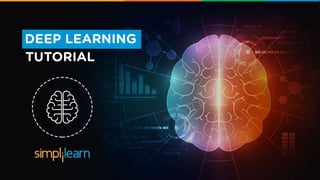





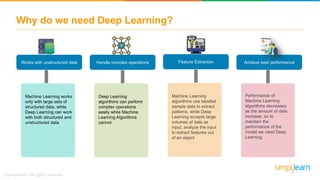



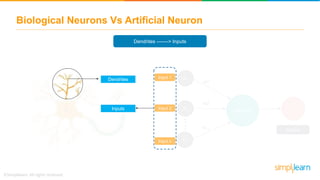

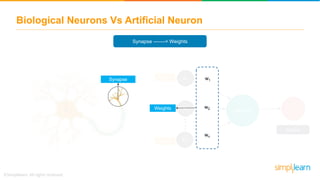






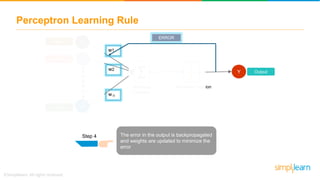





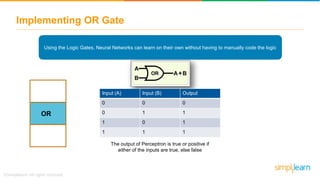



















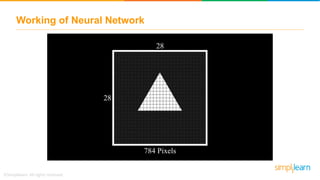
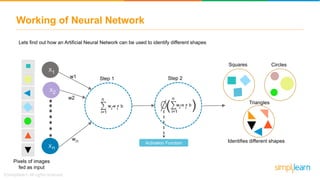

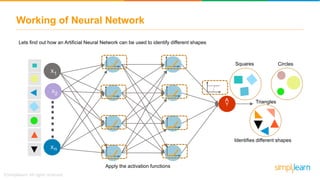

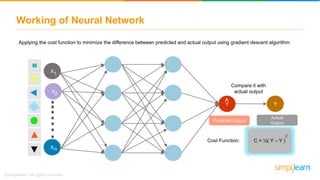







![Introduction to TensorFlow
• TensorFlow is a Deep Learning tool to define and run computations involving tensors.
• A tensor is a generalization of vectors and matrices to potentially higher dimensions.
• The array of data passed in each layer of nodes is known as Tensor.
a
m
k
q
d
2
4
8
1
1
9
3
2
5
4
4
6
6
3
3
7
8
2
9
5
Tensor of Dimensions[5] Tensor of Dimensions[5,4]Tensor of Dimension[3,3,3]](https://image.slidesharecdn.com/deeplearningtutorialdeeplearningtensorflowdeeplearningwithneuralnetworkssimplilearn-180427065503/85/Deep-Learning-Tutorial-Deep-Learning-TensorFlow-Deep-Learning-With-Neural-Networks-Simplilearn-59-320.jpg)

![Tensor Ranks
m=V=[1,2,3],[4,5,6]
v=[10,20,30]
t=[[[1],[2],[3]],[[4],[5],[6]],[[7],[8],[9]]]
s= [107]
Tensor of Rank 0 Tensor of Rank 1
Tensor of Rank 2Tensor of Rank 3](https://image.slidesharecdn.com/deeplearningtutorialdeeplearningtensorflowdeeplearningwithneuralnetworkssimplilearn-180427065503/85/Deep-Learning-Tutorial-Deep-Learning-TensorFlow-Deep-Learning-With-Neural-Networks-Simplilearn-61-320.jpg)

